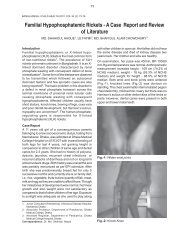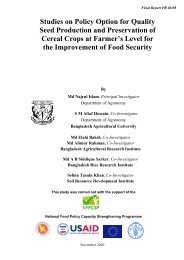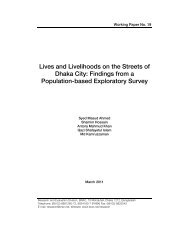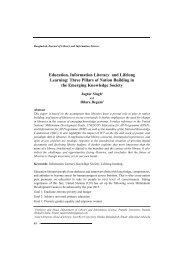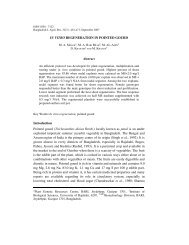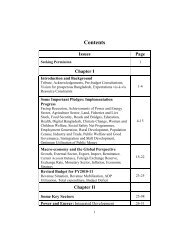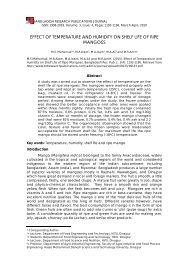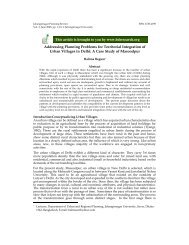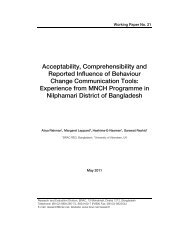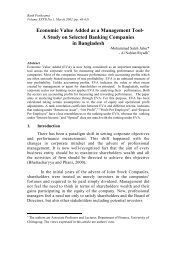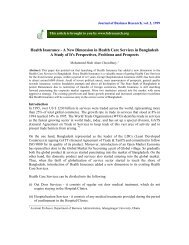Impact of Climate Change in Bangladesh: The Role of Public ...
Impact of Climate Change in Bangladesh: The Role of Public ...
Impact of Climate Change in Bangladesh: The Role of Public ...
You also want an ePaper? Increase the reach of your titles
YUMPU automatically turns print PDFs into web optimized ePapers that Google loves.
224 J. Ecol. Nat. Environ.<br />
last 100 years. <strong>The</strong> total temperature <strong>in</strong>crease from the<br />
period 1850 to 1899 to the period 2001 to 2005 has been<br />
0.76°C (New Nation, 2011a). Hasna<strong>in</strong> (2000) and WWF<br />
(2005) mentioned <strong>in</strong> their studies that s<strong>in</strong>ce the mid<br />
1970s, the average air temperature measured at 49<br />
stations <strong>of</strong> the Himalayan region rose by 10°C with high<br />
elevation sites warm<strong>in</strong>g the most (New Nation, 2011b).<br />
A recent review, published <strong>in</strong> Nature Geoscience,<br />
suggests that with elevated atmospheric carbondioxide<br />
levels, it has been anticipated that additional green house<br />
gas emissions from soils, forests, and wetlands, lead<strong>in</strong>g<br />
to more warm<strong>in</strong>g (Global <strong>Change</strong>, 2011). Accord<strong>in</strong>g to the<br />
International Panel for <strong>Climate</strong> <strong>Change</strong> (2007), an<br />
<strong>in</strong>crease <strong>in</strong> the average global temperature will lead to<br />
changes <strong>in</strong> precipitation, and atmospheric moisture due<br />
to the changes <strong>in</strong> atmospheric circulation, and <strong>in</strong>creases<br />
<strong>in</strong> evaporation, and water vapor. It was further supported<br />
by two new studies published <strong>in</strong> the British journal Nature<br />
(New Age, 2011a). <strong>The</strong> ecological <strong>in</strong>teraction <strong>of</strong> cities and<br />
their h<strong>in</strong>terlands is recurr<strong>in</strong>g theme. Rapid urbanization<br />
and climate change have given it a new impetus and<br />
sense <strong>of</strong> urgency. Expected population growth and<br />
migration mean that urban expansion will be the most<br />
common and universal development challenge. However,<br />
urban expansion can take the form <strong>of</strong> urban sprawl; it is<br />
then costly, wasteful, and ecologically destructive (Anna,<br />
2011). By 2050, the urban population <strong>of</strong> the develop<strong>in</strong>g<br />
world will be 5.3 billion; Asia alone will host 63% <strong>of</strong> the<br />
world‟s urban population, or 3.3 billion people. <strong>The</strong> UN<br />
predicts that there will be millions <strong>of</strong> environmental<br />
migrants by 2020, and climate change is one <strong>of</strong> the major<br />
drivers (Anna, 2011). Regardless <strong>of</strong> the specific causes<br />
and drivers, there is clear evidence that our climate is<br />
chang<strong>in</strong>g and that the pace and scale <strong>of</strong> that change is<br />
accelerat<strong>in</strong>g <strong>in</strong> many areas. <strong>The</strong> IPCC's fifth assessment<br />
will be released <strong>in</strong> 2013/2014, but already many teams <strong>of</strong><br />
scientists claim the forecasts and scenarios <strong>of</strong> future<br />
climate change <strong>in</strong> the fourth IPCC assessment are be<strong>in</strong>g<br />
overtaken. A recent conclusions from the Snow, Water,<br />
Ice and Permafrost <strong>in</strong> the Arctic report <strong>of</strong> the Arctic<br />
Monitor<strong>in</strong>g and Assessment Programme (AMAP), mentioned<br />
that there is likely global sea-level rise <strong>of</strong> close to 1<br />
m or more by the end <strong>of</strong> the century as a result <strong>of</strong>, for<br />
<strong>in</strong>stance, faster melt<strong>in</strong>g <strong>of</strong> the Greenland ice sheets. This<br />
compares with the 0.18 and 0.59 m forecast by the IPCC<br />
four years ago (New Nation, 2011a).<br />
<strong>Climate</strong> change is tak<strong>in</strong>g a toll on not only the ecology<br />
<strong>of</strong> nations around the world, but also their political,<br />
economic and social stability, with the poorest nations<br />
and the poorest <strong>of</strong> the rich nations be<strong>in</strong>g the worst<br />
sufferers ( Daily Star, 2011b). A one-meter rise <strong>in</strong> sea<br />
level could, for <strong>in</strong>stance, flood 17% <strong>of</strong> <strong>Bangladesh</strong>'s land<br />
area; threaten large parts <strong>of</strong> coastal cities such as Lagos,<br />
Cape Town and elsewhere and overwhelm, along with<br />
storm surges, small Island develop<strong>in</strong>g States from the<br />
Maldives to Tuvalu. A World Bank study has estimated<br />
that a one-meter sea-level rise would affect 84<br />
develop<strong>in</strong>g countries alone. Recent studies have found<br />
that up to 12% <strong>of</strong> the world GDP is already at risk from<br />
exist<strong>in</strong>g climate patterns. For example, the value <strong>of</strong> GDP<br />
exposed to tropical cyclones alone more than tripled from<br />
US$525.7 billion <strong>in</strong> the 1970s to US$1.6 trillion <strong>in</strong> the first<br />
decade <strong>of</strong> the 2000s (New Nation, 2011). <strong>The</strong> Global<br />
Susta<strong>in</strong>ability Panel, recently set up by UN Secretary<br />
General Ban Ki-moon, is an attempt to br<strong>in</strong>g a holistic<br />
approach to bear on issues, such as climate change,<br />
food, and water security, and development. However, it is<br />
has been felt that sufficient experience is lack<strong>in</strong>g with<br />
how to connect dots, how to br<strong>in</strong>g together concepts like<br />
climate change, and poverty eradication, climate change,<br />
and food security, and climate change, and access to<br />
water. Ultimately, if climate change is not be<strong>in</strong>g solved,<br />
then poverty eradication, food security, access to water<br />
cannot be solved either (Global <strong>Change</strong>, 2011).<br />
Secretary-General <strong>of</strong> UN, Ban Ki-moon affirmed that<br />
climate change was an "unholy brew" that could create<br />
perilous security vacuums, and that we must address a<br />
clear danger that not only exacerbated the threats but<br />
was itself a threat to <strong>in</strong>ternational peace and security<br />
(Daily Star, 2011k).<br />
<strong>The</strong> problem<br />
Firstly, there is a massive gap <strong>in</strong> <strong>in</strong>formation, an<br />
astonish<strong>in</strong>g lack <strong>of</strong> knowledge about how we should<br />
respond to the negative health effects <strong>of</strong> climate change.<br />
Secondly, s<strong>in</strong>ce the effects <strong>of</strong> climate change will hit the<br />
poor hardest, an immense task before us to address the<br />
<strong>in</strong>adequacies <strong>of</strong> health systems to protect people <strong>in</strong><br />
countries most at risk. Thirdly, technologies do have the<br />
potential to help us adapt to changes <strong>in</strong> climate. But<br />
these technologies have to be developed out <strong>of</strong> greater<br />
research <strong>in</strong>vestments <strong>in</strong>to climate change science, better<br />
understand<strong>in</strong>g about how to deliver those technologies <strong>in</strong><br />
the field and more complete appreciation <strong>of</strong> the social<br />
and cultural dimension <strong>in</strong>to, which those technologies<br />
might be implanted. Fourthly challenge is political<br />
creat<strong>in</strong>g the conditions for low carbon liv<strong>in</strong>g. And f<strong>in</strong>ally<br />
there is the question <strong>of</strong> how we adapt our <strong>in</strong>tuitions to<br />
make climate change the priority it needs to be (<strong>The</strong><br />
Lancet, 2011).<br />
Identify<strong>in</strong>g urgent and immediate research needs for<br />
evidence based action is another important step <strong>in</strong><br />
reduc<strong>in</strong>g the health risks <strong>of</strong> climate change. Fill<strong>in</strong>g these<br />
research gaps requires a susta<strong>in</strong>ed process to mobilize<br />
resources and update objectives as need change<br />
(Lancet, 2008) and crucially important is to build<br />
<strong>in</strong>terdiscipl<strong>in</strong>ary research capacity, with a focus on the<br />
low <strong>in</strong>come countries that are the most vulnerable to the<br />
health effects <strong>of</strong> climate change and have the weak<br />
research base (Diarmid et al., 2011). But the challenges<br />
are complex and daunt<strong>in</strong>g, and require cont<strong>in</strong>uous<br />
engagement and effort at all levels. A security <strong>of</strong>



